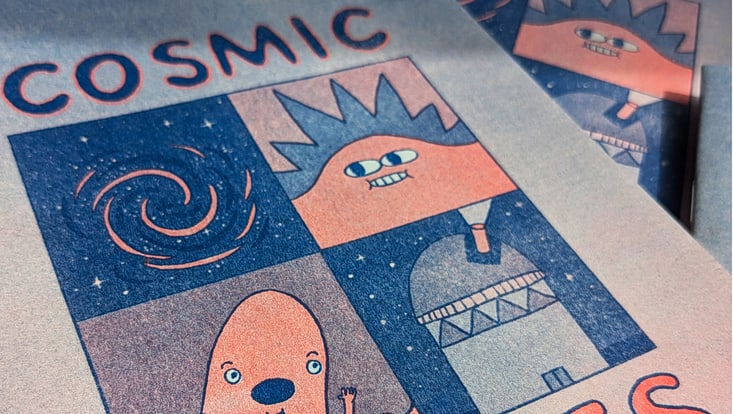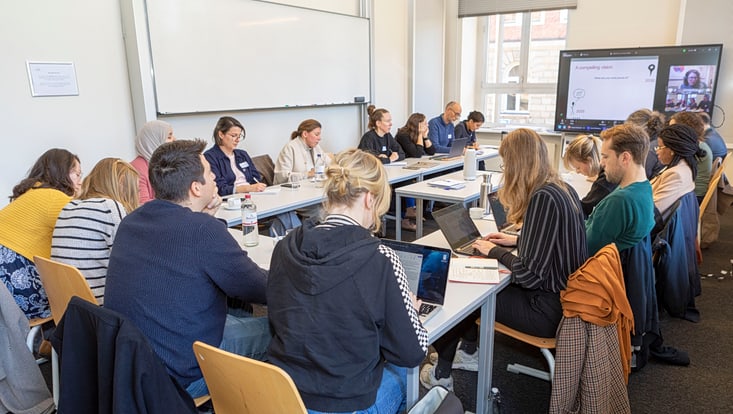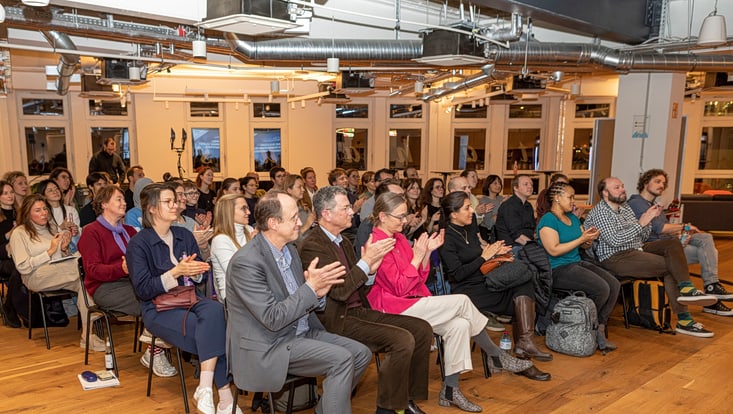Research communication fundingA powerful impulse for interactions – Maria Elidaiana da Silva Pereira on her project "Cosmic Waves"
17 April 2025

Photo: da Silva Pereira & Machado
In her project “Cosmic Waves”, astrophysicist Dr. Maria Elidaiana da Silva Pereira collaborated with the physicist and illustrator Camila Machado to create a zine – a small magazine sharing information on gravitational waves in a creative and accessible way. By using the zine as a starting point, she explained her own research to teenagers and general audiences on various occasions. The zine was funded by the Hamburg Research Academy support fund for research communication.
How did you come up with the idea for the project?
I have always been passionate about science communication and enjoy sharing my research and scientific concepts with the public. I believe it is crucial for scientists to engage with diverse audiences through creative mediums like podcasts, YouTube, and zines. The idea for this project was inspired by the work of physicist and illustrator Camila Machado, who uses zines as a form of artistic expression. Together, we had previously created a zine about the Hamburg Observatory for its Open Day, which demonstrated the potential of this medium to reach a broad audience. When I knew that the Observatory would co-host a music and science festival, I saw an opportunity to release a new zine focused on my own research topic, gravitational waves, combining art and science to engage festival attendees and beyond. The goal was to make complex scientific ideas accessible for teenagers and general audiences, fostering their curiosity and understanding.
Which challenges did you face when translating your research into graphical representations? Do you have tips for collaborating with an illustrator?
In the creation process of the zine, my role involved researching, writing the content, and working closely with the illustrator to ensure the science was accurately and creatively presented through both text and visuals. I was fortunate to collaborate with an illustrator who is also a physicist. Although we worked in different research areas, our shared scientific background made it easier to discuss and design visuals for the complex physical concepts presented. Additionally, I attended workshops on visualizing science and communicating science through comics. They helped me decide which information and visuals to include, especially given the 16-page limit. The most challenging aspect was being concise while maintaining clarity. To ensure a smooth collaboration, I communicated my personal wishes for the zine clearly, but also remained open to the illustrator’s suggestions. My advice is to find an illustrator whose style you appreciate, establish clear communication, and embrace the collaborative nature of the process. Teamwork and mutual respect are key to creating a successful project.
How did the support fund help you?
The funding allowed us to print the zine using the more artistic Riso technique at a local print shop (Risofort) and provided some compensation for the illustrator’s work.
How did you work further with the resulting zine?
We printed 500 copies of the zine, with 250 in German and 250 in English. So far, the zines have been distributed at different places, such as the Hamburg central library (Bücherhalle), the Elb-Lingua association for Brazilian Portuguese/German speakers and the Hamburger Sternwarte. Furthermore, my colleagues and me used the zine for different events – the Sternstunden Festival in July 2024 at the Hamburg Observatory, the 2025 Girls’ Day in April 2025 and a zine workshop called “Who Owns the Space?” at the 15th anniversary of the Gängeviertel. I’m happy to say that we definitely achieved our main goal of reaching a broad audience. Especially at the zine workshop in Gängeviertel, I received firsthand feedback from the public, who were enthusiastic and receptive. The zine was used as an example to inspire attendees to create their own zines on the topic of space exploration and occupation.
In the future, I may collaborate on a Portuguese translation; another colleague has also expressed interest in translating the zine into French. All these interactions show how powerful and useful zines can be as means for science communication. Personally, although I am no longer working in the academic environment, I hope I can use all these experiences with science communication in a future position in the industry sector.
Further information on the project
-
The zine is available online
-
Website of the Sternstunden festival
Research communication funding
You have a good idea, but do not have the funds you need to implement it? The Hamburg Research Academy, in conjunction with the Claussen-Simon Foundation, provides funding to early career researchers for projects in the area of research communication. You can apply for funding for you own projects from the Hamburg Research Academy fund.



